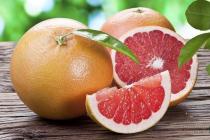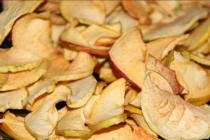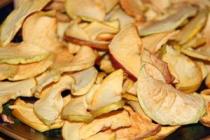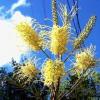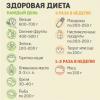Description
Sun-dried zucchini are one of the unique blanks for the winter, which are very easy to make at home. Many people believe that only salty dishes can be prepared from vegetables, but this is not at all the case. Currently, various preserves, jams, and also sweet vegetable purees are prepared from vegetables, which the whole family will enjoy in the future. This photo recipe will teach you how to properly dry vegetables at home, so that as a result, the preparation turns out to be sweet enough to taste and later used as a dessert.
In this case, the drying of zucchini delicacies takes place in the oven, but if the range of kitchen utensils has a special device for drying fruits, then it can also be used. In addition, in an electric dryer, the process of cooking vegetables is much easier, since such an electrical appliance has several cooking modes, which is very convenient for busy hostesses.
The structure of dried vegetables is considered the golden mean between fresh and dried foods. In the process of preparing a vegetable preparation, all the juiciness of fresh zucchini is lost, but at the same time the vegetables do not become dry, but are soft and sufficiently elastic. Such a wonderful dessert is very tasty to eat with tea. In this case, the zucchini sweetness dissolves pleasantly in the mouth, leaving an amazing aftertaste.
For a quick and easy creation of a dessert vegetable preparation at home, we have prepared a technological step-by-step instruction, so we suggest you start studying it immediately.
Ingredients
Sun-dried zucchini - recipe
To quickly prepare zucchini goodies for the winter, you must first prepare for this all the ingredients listed in the recipe. For this harvesting of zucchini, young ones should be chosen so that there are as few seeds as possible inside them..

Now we rinse the selected fruits thoroughly in cold water and dry them with napkins. Next, cut clean vegetables into thin slices, the thickness of which should not exceed five millimeters. The zucchini rings should be more or less even so that they can be cooked at the same time in the end.

Place the sliced zucchini circles in a suitable bowl and add granulated sugar to them.

Then mix the contents of the bowl well and leave the vegetables for twelve hours to separate their own juice.

After this time, the sugar is completely dissolved in the separated zucchini juice, which will allow the vegetables to be thoroughly saturated with the sweet syrup. The contents of the bowl should be stirred periodically so that in the end all the vegetable rings are soaked equally.

Now from the infused zucchini circles, separate all the juice through a sieve. Please note that the fruits have significantly changed their structure.

We move the squeezed vegetables onto a baking sheet covered with parchment paper and place it in the oven, which should be preheated to one hundred degrees. Cooking zucchini will take about three hours.
Zucchini is rich in mineral salts of potassium, magnesium, phosphorus and calcium in large quantities, sodium, sulfur and others - in less. They are essential for normal metabolism. Also, zucchini contains important trace elements that the body needs, such as aluminum, zinc and others.
Zucchini is also rich in vitamins. It contains vitamin C, which is very important for the growth and intensive repair of cells; vitamin B1, which is necessary for carbohydrate, protein and fat metabolism; vitamin B2 for the health of skin, hair, nails, and the whole organism as a whole; carotene, niacin and other vitamins.
Also zucchini is very useful for people with diseases of the gastrointestinal tract, since it activates its work, it is easily absorbed and does not irritate the stomach. Zucchini is often used as a sedative.
themselves are surprisingly low in calories, however, drying in syrup implies the presence of a large amount of sugar, which is why the calorie content of zucchini increases sharply - about 200 kcal per 100 g. If, instead of full-fledged drying, you simply dry the zucchini, then it will be an excellent addition to the diet menu. Calorie content - 24 kcal per 100 g.
Fundamental rules
A special charm of dried zucchini is that they do not need any special preparation or careful selection of fruits... Both young and already fully matured will do.
It must be remembered that when dried, a very small amount of product is obtained at the exit, so if you want zucchini not for a one-time snack, but for a constant addition to the main diet, then you will need a lot of zucchini.
The oven-dried zucchini option is the most popular among housewives, so we advise you to try this method first. For drying, you will need a large baking sheet on which you will spread the zucchini. Instead of an oven, a special electric dryer with a mesh is also suitable.
Also you need to take care of the container in advance where the ready-made zucchini will be stored... For these purposes, you will need glass jars with a tight lid.
Instructions
There are two most common ways to dry zucchini: with or without your own syrup. In the first case, zucchini are very tender and perfectly replace any sweets.
You will need:
- a kilogram of zucchini;
- 1 orange;
- 1 lemon;
- 500 g of sugar.
How to wither zucchini in your own syrup:

The second way is drying without syrup is much easier and faster.
You will need:
- a kilogram of zucchini;
- 300g sugar;
- sachet of citric acid 5 g;
- bag of vanillin 5 g.
How to do:
- Peel the zucchini and seeds and cut into pieces.
- Place the slices in a cup and cover with sugar and citric acid. You can add some vanillin.
- Set the oppression and leave for 5-6 hours.
- Separate the zucchini from the juice, strain and place on a baking sheet or grid in an electric dryer.
- Zucchini are dried at a temperature of 60 ° C until tender (how is it right?).
- Finished zucchini can be sprinkled with sugar or even syrup.
Recipe
Nowadays, the recipe for dried zucchini in Korean is especially popular. And for its execution you will need:
- a kilogram of zucchini;
- vinegar;
- salt;
- 4 garlic cloves;
- spices for carrots in Korean.
How to cook:

There are a lot of options for dishes made from dried zucchini, so be sure that if you wilted zucchini, then they will definitely not lie idle. After all, they can be prepared not only as an independent dish, but also in addition to any others.
And some cooking methods give the zucchini a mushroom flavor. So enjoy not only the variety of zucchini flavors, but also their benefits.
If you find an error, please select a piece of text and press Ctrl + Enter.
Zucchini is a valuable dietary product with a rich set of vitamins and excellent taste. It will be indispensable in your diet if you prefer healthy and nutritious plant foods. True, you can only eat enough fresh zucchini in the summer season, and in order to enjoy the taste of the vegetable throughout the year, many housewives resort to preparations: canned vegetables and salads, marinades and even zucchini jams. But in this case, the product loses many useful qualities. A worthy alternative to the usual zucchini is to dry the vegetable. If you do not know what can be made from dried zucchini and how to properly organize this process, then we can figure out the issue.
Are the beneficial properties preserved during drying
Since ancient times, people have resorted to drying vegetables, fruits, herbs and berries, as it was a vital necessity. Currently, there are many ways to preserve food - freezing, canning, pasteurization and others. But drying products is still the most profitable financially, a simple and convenient method in which the product retains all its original taste and vitamin properties.  During the drying process, vegetables lose up to 4/5 of the amount of moisture, and since zucchini consists of 90% liquid, then from 10 kg of fresh fruits you will get 1 kg of dried fruits, respectively.
During the drying process, vegetables lose up to 4/5 of the amount of moisture, and since zucchini consists of 90% liquid, then from 10 kg of fresh fruits you will get 1 kg of dried fruits, respectively.
Did you know?In some cuisines of the world, not only fruits, but also squash flowers are eaten. Their application is multifaceted: bright yellow petals are added to main dishes, appetizers and salads, desserts and pastries. Thanks to the same flowers, the fruit was cultivated for a long time in Europe as an ornamental, and not a food plant.
Advantages and features of this method:
- Preservation of all macro- and microelements, vitamins. During conservation, many useful compounds are destroyed, but during drying, only moisture evaporates from vegetables and fruits.
- Profitability. If you do not have a special electric dryer, you can always use an oven. And if you live in a private house, you will surely find a place to dry the fruits in the open air. In this case, no additional devices are required. And at the end of the process, the dried product will only have to be collected and correctly stored.
- Naturalness of products. When buying ready-made dried fruits, you can never be sure that preservatives and chemicals for treating pests have not got into them. If you cook dried zucchini yourself at home, then you can be sure of their quality and organicness.
- No oxidation. The oxidation process requires the presence of water, since it is a universal transporter for all substances. But if there is no moisture, accordingly, the oxidation process does not occur.
- Lack of development of pathogenic microorganisms.
- Absolutely any varieties of zucchini are suitable for drying.
 If you follow the drying technology, you can save up to 90% of all nutrients. It should be borne in mind that vitamin C most "badly tolerates" high temperatures (up to 55-60 ° C), vitamins A and B can be preserved at higher rates on the thermometer (up to 75 ° C), but micro- and macroelements can withstand temperatures up to 85-90 ° С.
If you follow the drying technology, you can save up to 90% of all nutrients. It should be borne in mind that vitamin C most "badly tolerates" high temperatures (up to 55-60 ° C), vitamins A and B can be preserved at higher rates on the thermometer (up to 75 ° C), but micro- and macroelements can withstand temperatures up to 85-90 ° С. The only drawback of drying food can be considered a loss of the appearance of the fruit. However, this does not in any way affect the taste, smell and nutritional value!
The benefits and harms of dried zucchini
Since, when dried, zucchini retains almost all substances, the benefits of dried and fresh fruits are almost the same. So, the fruits have the following advantages:
- Rich in vitamin composition. 100 g of fruits contain vitamins (in descending order): C, B3, E, B1, B2, B6, as well as beta-carotene, folic, nicotinic and malic acids, antioxidants.
- A treasure trove of micro- and macroelements: potassium, phosphorus, magic, calcium, iron, zinc, selenium and manganese are present in smaller amounts.
- Low in calories. It is difficult to gain extra pounds from this vegetable, since 100 g contains only 23 Kcal (fresh).
- Not allergenic. Zucchini can be consumed even by the smallest children from 7 months. In exceptional cases, this vegetable can cause allergies in an adult.
- Highly digestible.
- Approved for use by pregnant and lactating women.
Did you know?According to one legend, zucchini is considered a gift from the gods. At a time when the main food of people was fish, and many sailors went to fish for a long time at sea, women asked the gods for food that would grow on land. It was supposed to have soft flesh like a fish, a sunny color like a sun-drenched sea, and a hard skin like a turtle's shell. The gods had mercy and gave this fruit to mankind.
 Eating fresh and dried zucchini has an effect on the body following effects:
Eating fresh and dried zucchini has an effect on the body following effects:
- improves digestion;
- normalizes the functioning of the nervous system;
- enhances immunity;
- normalizes the work of the heart, blood vessels;
- useful for obesity and overweight;
- suitable for people with diabetes;
- reduces the risk of developing malignant tumors.
However, with certain diseases, eating zucchini, even in dried form, can harm the body. So, the fruits should not be eaten in case of kidney diseases, since the fruits contain a lot of potassium. If there are diseases of the stomach and intestines (ulcer, gastritis, etc.), you also need to minimize the amount of fetus in the diet - zucchini can irritate the mucous membrane. In any case, ask your doctor for advice before using fresh or dried zucchini.
Selection and preparation of zucchini for drying
It is best to choose young, small (10-20 cm) fruits for drying with intact skin and green tail. Compared to large fruits, they have a more tender pulp and a greater amount of nutrients.  What vegetables to avoid:
What vegetables to avoid:
- Partially peeled. This is how unscrupulous sellers try to hide traces of rot and damage.
- With a shiny, unnatural, bright skin. Such a skin indicates the use of nitrates during cultivation.
- With a dry stalk. This sign also indicates the presence of nitrates in the fruit.
- With cracked, flaky skin. These symptoms indicate a plant disease.
As mentioned above, zucchini of any varieties, types and colors are suitable for drying. Both early maturing and late maturing species can be used. If you want to dry large fruits, you will need to remove the seeds.
Process preparing zucchini to different drying methods is almost the same. It consists of such steps:
- Rinse the vegetables thoroughly, cut off the stem and tail.
- If you are using very young zucchini, they can be left in the skin. It is better to cut the coarse, thick skin from large fruits.
- Extract the seed from large vegetables with a spoon.
- Next, the fruits must be cut into strips, cubes, rings or half rings. Optimally cut into slices 1-1.5 cm thick.
- The pre-chopped vegetable can be dried immediately or boiled for 1-2 minutes, and then cooled sharply in cold water. Instead of boiling, some housewives advise salting the zucchini (for juicing), then rinsing off the juice and starting drying. With short-term cooking, it will be possible to extract nitrates from the vegetable (if any), but the amount of useful vitamins will also be reduced.
 After the preparatory stage, it is necessary to choose the method of fruit drying.
After the preparatory stage, it is necessary to choose the method of fruit drying. Popular drying methods
For drying, you can use both the most ancient methods (in the air), and with the help of modern technology (ovens, dehydrators). The first method will be somewhat time-consuming, but economical. And in a dehydrator in a short time it will be possible to dry quite a lot of fruits.
On open air
With the natural method of drying, the process can take from several days to three weeks. For drying, you need to choose sieves, grates, any flat trays with holes in the bottom. The fruits should be spread out at a short distance from each other and placed in the sun. In order to achieve uniform drying, they must be turned over 1-2 times a day.
Important!You cannot choose trays and pallets with a solid bottom for drying in the sun - due to the lack of air circulation, the fruits may begin to rot, which will destroy the entire workpiece.
It is also extremely important not to allow the workpiece to come into contact with flies, midges and other insects. For this, the dryer can be covered with a net. However, it should not obstruct the sun's rays.  Another natural drying option is indoor drying. To do this, cut vegetables are strung on a fishing line, thread or wire and hung in a well-ventilated room without drafts. However, even here you have to take care that insects and other living creatures do not attack the workpiece.
Another natural drying option is indoor drying. To do this, cut vegetables are strung on a fishing line, thread or wire and hung in a well-ventilated room without drafts. However, even here you have to take care that insects and other living creatures do not attack the workpiece.
In the oven
With this method, zucchini will dry in 6-8 hours. You can use a baking sheet and baking paper to dry. Put the sliced fruits on the paper while maintaining the space between them, preheat the oven to 50–55 ° С and send the baking sheet there. The door can be left barely open for ventilation.
It is necessary to systematically turn the chopped vegetables and change them to change their position at the back of the oven and at the entrance. If after this time you take out the baking sheet and find that the dried zucchini are not yet ready, they can be sent to the oven again for 1-2 hours. 
In an electric dryer
This method is similar to the previous one, but shorter in time and more convenient. Although to use it you will have to spend money on an electric dryer - this device is not in every home.
Today, models of electric dryers (dehydrators) differ in the following indicators:
- power;
- the number and location of trays (horizontal / vertical);
- shape (round, square and rectangular);
- placement of the heating element and ventilation (front / bottom / top). In some models, in which ventilation and heating are provided evenly, you will not need to remember about turning the dryer at all;
- on noise impact (newer and more expensive models operate almost silently).
 In general, the process of drying zucchini in the dryer is extremely simple: the washed and chopped fruits are laid out on baking sheets, the required temperature is set and the baking sheets are sent inside. After 4-5 hours, the finished product must be removed from the dehydrator. Drying zucchini in an electric dryer is the most modern and rational method of drying, since by choosing a suitable model of the dryer, you can dry a large number of fruits in a short time, while your participation in the drying process will be minimal.
In general, the process of drying zucchini in the dryer is extremely simple: the washed and chopped fruits are laid out on baking sheets, the required temperature is set and the baking sheets are sent inside. After 4-5 hours, the finished product must be removed from the dehydrator. Drying zucchini in an electric dryer is the most modern and rational method of drying, since by choosing a suitable model of the dryer, you can dry a large number of fruits in a short time, while your participation in the drying process will be minimal. Important! Each dehydrator model is designed and works in its own way, therefore, before using the device, you must definitely study the instructions and figure out exactly how it is better to dry certain fruits in your model.
How to check readiness
The duration of the process will depend not only on the drying method and on the characteristics of the appliance (oven or dehydrator), but also on the fruits themselves. So, duration varies depending on:
- the amount of sugar in fruits;
- initial water content;
- the method of cutting and the size of the pieces;
- ventilation quality;
- outdoor air temperature or set temperature regime;
- air humidity;
- features and characteristics of the device (if you use an artificial method).
 In any case, it is necessary to determine the readiness of the fruits by their external characteristics: they must be elastic, but not release moisture. The surface may darken slightly and wrinkle. At the same time, dried fruits should not resemble dried ones - in this case, they need to be dried. It is also important to try the readiness of the chilled product, since it is easy to make mistakes in a warm state.
In any case, it is necessary to determine the readiness of the fruits by their external characteristics: they must be elastic, but not release moisture. The surface may darken slightly and wrinkle. At the same time, dried fruits should not resemble dried ones - in this case, they need to be dried. It is also important to try the readiness of the chilled product, since it is easy to make mistakes in a warm state. Did you know?The largest and heaviest squash was grown in England in 2008. The weight of this handsome man reached 65 kg. For such a gigantic size and weight, the vegetable hit the pages of the Guinness Book of Records.
How to store dried zucchini
It is best to use glass jars with a sealed metal or plastic lid for storing finished products - moths, larvae and other pests are definitely not afraid of drying in such containers.  Sometimes you can find recommendations for storing drying in cotton bags, pre-soaked in a salt solution. Also, the drying itself can be mixed with a small amount of salt. However, even in this case, a moth may start in the product. In any case, the container should be left at room temperature in a dark place.
Sometimes you can find recommendations for storing drying in cotton bags, pre-soaked in a salt solution. Also, the drying itself can be mixed with a small amount of salt. However, even in this case, a moth may start in the product. In any case, the container should be left at room temperature in a dark place.
Another way to store dried zucchini is in the freezer. This method is especially relevant if you are a little underdried.
You can not store drying in iron, plastic containers, plastic bags - due to the lack of sealing, zucchini will absorb moisture from the air and soften, and can also be affected by pests. If you have properly prepared, dried and stored drying, it will stand until the next season and even longer.
What can be made from dried zucchini
There are many recipes that use winter-dried zucchini. They will be a popular ingredient in vegetable stews, first courses, vegetable sauces and casseroles. From dried fruits, you can cook porridge using this vegetable as the main ingredient, fry and make scrambled eggs, warm salads with them.  For gourmets and fans of experimenting with tastes, it will be interesting to make a cake from dried fruits with the addition of greens. Write in the comments which questions you did not receive an answer to, we will definitely respond!
For gourmets and fans of experimenting with tastes, it will be interesting to make a cake from dried fruits with the addition of greens. Write in the comments which questions you did not receive an answer to, we will definitely respond!
257
once already
helped
04.06.2015 2 908 0 ElishevaAdmin
Candied fruits, drying and freezing
Dried foods are, in principle, prepared according to the same principle as dried ones - by airing and removing excess moisture. But the difference is very significant: during drying, such high temperatures are not used as during drying. The process proceeds slowly, without the participation of direct sunlight, and moisture is not completely excluded, but remains in a certain amount inside the dried product. Therefore, it remains soft and elastic, while dried foods are brittle and hard.

But it is precisely due to such a slow and gentle cooking that useful substances are maximally preserved in dried products. Dried vegetables and fruits are useful for pregnant women, as well as in almost all diets, including weight loss diets.
Since dried vegetables and fruits are such a useful product, modern home technologies also provide for drying modes in drying cabinets, gas and electric, and other household appliances. Therefore, current housewives do not need to put vegetables and fruits in the breeze for a long time, guard them from flies and the hot sun. You can do all this easier and faster. When starting to dry, one must remember that only very juicy products that are not able to dry completely are suitable for drying.

First, juice is extracted from such products, which can be prepared for the winter on its own or as part of some compositions. The mass remaining after the extraction of the juice is dried, while the temperature should not rise above 65 degrees.

A product that has fully matured is absolutely edible and can be eaten in its natural form. Such fruits and vegetables are very good, you can feast on them like sweets. And if you pour boiling water or just hot water over them and let it brew, you get a wonderful compote. Just two hours to make the compote tasty.
Dried products are used in baked goods, as a filling or decoration, they are used to prepare exceptional desserts. You can add them to salads and side dishes, use them as a seasoning for meat and fish.
Dried foods are stored in paper bags or glass jars, securely sealed. You just need to make sure that they do not get damp, otherwise, if they start to grow moldy, they will have to be thrown away.

Dried cherry
It is often used as a substitute for raisins and was called cinnamon in old recipes. If you come across such a name, you will know that it is a dried cherry.
Ingredients
Cherry, 3 kg
Sugar, 800 g
Water, 1 l
1. We sort out the cherries, cut off the tails, wash them and get rid of the seeds.
2. Cook the syrup 1x1 and immerse the cherries in it for 7-8 minutes. We do this in small portions, arranging a conveyor. Place the cherries removed from the boiling water on a sieve.
3. When all the cherries have passed through boiling water, glass and cooled down, place the berries on a baking sheet or dish and take them out into the shade and into the air. We use the syrup on the farm - we cook compote or just drink tea with it.
4. Berries, brought out to dry, turn over in 2-3 days. As the berries dry out, they will decrease, and the dish will have to be changed to a smaller one.
5. The drying process will be completed in 2 weeks. We transfer the cherries to a glass container and close.

Dried carrots
Ingredients
Carrots, 1 kg
Sugar, 200 g
Citric acid, 3 g
1. Peel the carrots and cut them into ½ cm thick circles.
2. Mix sugar with vanilla and acid, pour carrot circles. We put it in a container, set the oppression and wait for the juice to appear.
3. We put the pan to warm, when it boils, remove it from the stove and drain the juice. Lay out the remaining circles to dry. Dried carrots should remain supple.
Sun-dried zucchini
Ingredients
Zucchini, 1 kg
Sugar, 200 g
Citric acid, 5 g
Vanillin, 5 g
1. We clean the zucchini from the skin and from the seeds, cut into pieces. Mix the sugar with vanilla and acid and pour in the zucchini pieces.
2. Press them down in an enamel bowl.
3. When the juice stands out, drain it and roll it up, having boiled it beforehand.
5. Pieces of zucchini are dried in a non-hot oven and placed in a glass container for storage.
We deal with the melon in the same way - the juice rolls up, and the pulp is dried. Dried melon is something special!
Dried pumpkin with apples
Ingredients
Pumpkin, 1 kg
Apples, 1 kg
Sugar, 400 g
1. From the pumpkin we take into work only pure pulp. Cut it into pieces, sprinkle with sugar.
2. In the same way, we put it under oppression in a cool place, for 8-10 hours.
3. Drain the juice and roll it up, boiling it.
4. Dry the pumpkin slices in the oven at 60 ° C, store in glass.
Dried gooseberries
Ingredients
Gooseberry, 1 kg
Sugar, 200 g
For drying, gooseberries should be taken large green, not fully ripe.
1. We cut the washed berries lengthwise or simply prick with a fork. Sprinkle with sugar and put in a cool place for 8-10 hours.
2. We use the juice for harvesting for the winter.
3. After removing the juice, heat the berries in a saucepan to 85 ° C, collect with a slotted spoon and send them to dry in the oven.
4. After drying in the oven, transfer to glassware and store in the cold, closed.

Sun-dried sugar beets
Ingredients
Sugar beet, 1 kg
Citric acid, 3 g
1. Wash beets in their skins and scald with boiling water. Then we remove the skin, as from a young potato.
2. Cut the beets into slices, put them in a saucepan and add citric acid.
3. Evaporate slowly, 2 hours, but make sure that there is no burning.
4. Let the beets cool in a saucepan, then spread them on a baking sheet and into the oven for drying at 60 ° C.

Dried physalis
Ingredients
Physalis, varieties "Berry" or "Confectioner", 1 kg
Sugar, 200 g
1. Remove the covers, pour boiling water over the fruits and wipe each one with a clean cloth.
2. Cut the fruit in half and sprinkle with sugar.
3. After keeping in the cold for 8-10 hours, heat up to 85 ° С.
4. We wait until the fruits have cooled, and remove them from the pan with a slotted spoon.
5. Dry in the oven at 65 ° C, store in glass. Boil the juice and roll it up.

Dried pears
Ingredients
Pears, 1 kg
Sugar, 200 g
1. From the pear, leave only the pulp, which we cut into pieces.
2. After sprinkling with sugar, place under oppression and wait 8-10 hours.
3. Drain and roll up the juice, and dry the pear pieces in the oven.
The resulting dried pear has a wonderful taste and aroma. Apricots, peaches, plums cooked in the same way are not inferior to it. These dried fruits can be eaten for breakfast for those who love muesli. Adding a handful of dried fruit to the flakes, all that remains is to pour the mixture with yogurt to infuse a little - and get a healthy light breakfast of divine taste.
And what juice remains for the winter! And he drinks with pleasure.

Dried rhubarb
Ingredients
Rhubarb stalks, 1 kg
Sugar, 300 g
1. Cut the petioles into slices, sprinkle with sugar and put under oppression.
2. After a day, drain the juice, boil and roll up.
3. Dry the petioles at 60 ° C.
4. We store dried rhubarb in a linen bag or in a cardboard box. It actively absorbs odors, so this fact must be taken into account when choosing a storage location.

Sun-dried tomatoes
The recipe for sun-dried tomatoes came to us from sunny Italy. Sun-dried tomatoes are skyrocketing in popularity and with good reason. Firstly, this is an inexpensive snack with excellent taste, it is not difficult to prepare it. In addition, sun-dried tomatoes can be used in other ways, putting them in soups, pizza and meat dishes.
When the tomatoes are born and they do not have time to properly process them, it is advisable to dry them out. In autumn I don't want pickled tomatoes yet, so the sun-dried ones will be used. And since they are delicious, the people will be happy.
Ingredients
Tomatoes, 1½ kg
Coarse salt, 1 tsp
Deodorized vegetable oil
Provencal herbs, 1 tsp
1. Cut the tomatoes into halves. We harvest the seeds, together with the juice, use them on the farm.
2. Cover the baking sheet with parchment, lay out the halves, cut up. Sprinkle with salt and herbs on top, drip with oil.
3. Put in the oven at 100 ° C for 3-4 hours. The oven door must be kept ajar to allow moisture to evaporate from the tomatoes.
4. Finished tomatoes should dry out 3-4 times, but remain flexible and moist, slightly caked. They should be checked along the way, and some should be removed earlier if they are ready.
5. We store sun-dried tomatoes in glass jars under a layer of odorless oil. They are infused and themselves are a savory snack. And you can store them in oil for 3-4 months.
Dried apples
Ingredients
Apples, 2 kg
Sugar, 200 g
1. Leave only the pulp from the apples, without breaking the shape.
2. Sprinkle with sugar and put under oppression in the cold.
3. After 8 hours, drain the juice and use it at your discretion.
4. Dry the apples in the oven at 60 ° C and place them in boxes or jars.
Sun-dried eggplant
Ingredients
Young eggplants, ½ kg
Vegetable oil, 120-150 g
Garlic, 1 large wedge
Paprika, 2/3 tsp
Chopped red hot pepper, ¼ tsp
Rosemary or basil, ½ tsp
1. Peel the eggplants. Cut into thin slices, about ½ cm.
2. Salt and wait for the bitterness to come out. This is 10-15 minutes.
3. Drain the juice, blanch the eggplant plates for a short time, just a few minutes.
4. Spread the plates on a baking sheet, dry for 2½ - 3 hours at 50 ° C.
5. By this time, we are guessing with filling, preparing it by mixing all the products indicated in the recipe.
6. Dried eggplants, dry on the outside and a little soft on the inside, put them in a jar. No need to ram, let them lie free. Pour the prepared filling into them and put in the refrigerator.
7. In order for them to become tasty, it is necessary to soak them in oil for several hours. But actually, the more they cost like that, the tastier they become.
8. Sun-dried eggplants are not stored outside the oil.
The process of drying zucchini lasts 31 hours in the Isidri Ultra dryer on 19 trays at a temperature of + 55 ˚С.
The air temperature in the room was + 28 ˚С. The Ezidri dryer consumed 18 kW of electricity.
Of 18 kg of zucchini, the skins were 3.4 kg. Young zucchini need not be skinned.
The result is 760 grams of dried zucchini.
****************************************************************************
Zucchini is well known to people all over the world. Even the ancient Indians in Mexico grew this vegetable and eaten it many years before our era. And today the zucchini does not lose its popularity, and in almost every vegetable garden, garden plot, you can see numerous yellow, white, green fruits. The harvest of zucchini is most often very large and many people, not knowing where to use this vegetable, sometimes just feed it to livestock or poultry. However, zucchini can be used in many dishes, and not only fresh, but also processed. And it is good for heat treatment, as it allows you to keep the product high quality and for a long time.
There are two beautiful legends about the appearance of zucchini. According to one Indian woman, while waiting for their husbands - fishermen, asked the gods to give them a vegetable that would grow on earth, but had the magical taste of seafood. According to another legend, this vegetable appeared in the Old World thanks to the Spanish conquistadors along with tobacco, potatoes and chocolate. There is an opinion that the Italians began to dry zucchini for the first time, but nothing is known for certain about this fact.
Useful properties of zucchini
Salad
Dried zucchini are boiled in salted water for about 15 minutes. During this time, you can peel the garlic, grate the lemon zest and squeeze the juice out of it. The zucchini are thrown in a colander so that the excess liquid is glass. Garlic is fried in olive oil and added to it zucchini, lemon zest and juice, as well as herbs. For spicy lovers, you can add chili pepper. Everything is mixed and left under the lid for 3 minutes on the lowest heat. The warm salad is ready. Delicious zucchini with an expressive mushroom aroma are obtained. For 100 grams of zucchini, you need half a lemon, a couple of tablespoons of olive oil, 2 cloves of garlic and herbs to taste.
If you grind dried zucchini into flour, then excellent pancakes are prepared from it, replacing wheat flour. This is very useful, since such pancakes will not gain excess weight.
Dried zucchini may well be used in those dishes where these vegetables are traditionally used fresh, just remember that the flavor concentration in them is greater, the aroma is sharper.
If in the summer, when there is an abundance of vegetables, fruits, and herbs, many neglect a vegetable such as zucchini, cook little variety of dishes from it, then in winter the attitude towards it changes. How nice it will be in winter to open a jar with this dried vegetable, cook the first and second courses from it, crunch fragrant chips and remember the summer. In the cold season, even those who are indifferent to zucchini should try to cook them in various forms. And the Ezidri vegetable dryer will help preserve this healthy vegetable with virtually no loss of everyone
its useful properties.
*********************************************************************************************
Our experience in drying vegetables in the Ezidri dryer.
Eggplants, zucchini, cucumbers were washed, peeled, cut and put on trays. Vegetables were dried for 8 hours
at + 50 ° C on 6 trays in the Ezidri Snackmaker dryer.


